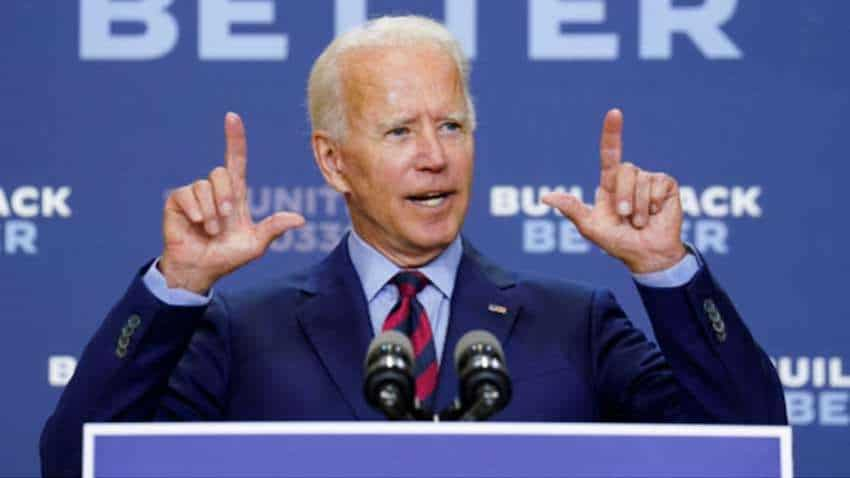US election result 2020: This is the strategy that won Joe Biden the presidency, beat Donald Trump
US election result 2020 - winning strategy: Three days before Election Day, Democratic presidential candidate Joe Biden was leaving nothing to chance. Polls showed him with a steady, but small, lead in the battleground state of Michigan, a must-win to take the White House.

US election result 2020 - winning strategy: Three days before Election Day, Democratic presidential candidate Joe Biden was leaving nothing to chance. Polls showed him with a steady, but small, lead in the battleground state of Michigan, a must-win to take the White House.
At a socially distanced, drive-in rally on Belle Isle Park, near downtown Detroit, Motown legend Stevie Wonder performed. Then came the ultimate star power: Barack Obama, the nation`s first Black president, urged voters in the 78% African American city to cast their ballots for Biden, his former vice president.
Michigan was part of a troika of Rust Belt states that Republican Donald Trump had snatched by the narrowest of margins from Democrats in 2016 to win the presidency. If Biden could retake Michigan, Wisconsin and Pennsylvania, he would be in a prime position to topple the incumbent. While polls showed that as many as seven other states had emerged as competitive contests, Biden devoted the lion`s share of his travel schedule to the Big Three down the stretch. The campaign and a bevy of Democratic groups prioritized their ad spending, direct voter contacts and get-out-the-vote efforts there.
That disciplined strategy proved just enough to help Biden secure the 270 Electoral College votes needed to win the presidency, a tally he surpassed on Saturday, after Pennsylvania put its native son over the top. Broadcast networks called the race for the Democrat, who broke the record for the most number of votes cast for any presidential candidate in history.
Biden was also the first Democrat in almost 30 years to be on the verge of winning Georgia. And he was clinging to a small lead in Arizona, which last voted for a Democrat nearly a quarter of a century ago. Those additional states, if they hold, would turn a narrow Electoral College victory for Biden into a bruising Trump defeat.
Trump supporters may see it differently. The incumbent, who received more votes than any Republican candidate in history, has sought to de-legitimize the outcome by claiming, without evidence, that he was cheated. There will likely be recounts in several states. And Trump continues to wage legal fights to nullify the results.
Still, Trump faces a formidable struggle to prevail in the Electoral College math that decides U.S. elections. Each state is allotted electoral votes equal to its number of senators and representatives in Congress. In most states, the candidate that wins the popular vote takes all its electoral votes, no matter how close the margin of victory.
In winning, Biden built a coalition of African Americans, women, college-educated professionals and seniors, while peeling off some anti-Trump Republicans and working-class white men who had defected to Trump in 2016 but since soured on him. At a time when progressives in the Democratic Party were pushing for big, structural change, the 77-year-old staked out the moderate lane and bet - correctly - that voters would coalesce around him as their best shot to knock off Trump.
The Biden team pushed supporters to embrace mail voting and early in-person voting, allowing the campaign to build a cushion heading into Election Day that would hold in places where it was needed most. And it deployed an army of attorneys to fight Republican attempts to limit voting access and throw out ballots in some Democratic-heavy areas.
The tumultuous events of 2020 also played a role, making Biden a particularly strong fit for the political moment.
A national emergency - a coronavirus pandemic that has claimed more than 236,000 American lives - made Biden`s deep government experience suddenly appealing after Trump’s chaotic, seat-of-his-pants presidency. Biden called for an end to the partisan rancor that has polarized the country. And his longstanding ties to the Black community made him a credible, calming voice on race relations amid strife over the deaths of George Floyd and others at the hands of police.
Interviews with Biden aides, rival Democratic campaigns and other prominent Democrats detailed how Biden and his inner circle settled upon a message and a strategy early on - and stuck with it.
"I haven’t changed what I’ve been saying since the day I announced," Biden said on Election Day as he wound up his campaign.
Unlike some of his Democratic competitors for the nomination, Biden didn`t cater to the party`s progressive wing during the primary and so didn`t need to tack back to the center once he squared off with Trump.
His plans to expand health care, tackle climate change and promote social justice were tempered by his desire to fine-tune rather than reform. He opposed a plan for European-style national health insurance known as “Medicare for All,” preferring to build on the Affordable Care Act, the system crafted during the Obama administration that provided coverage for millions of Americans. He defended fracking, the process of injecting high-pressure liquid to extract oil and gas. He resisted calls to defund urban police departments.
That didn’t stop the president and his allies from tarring Biden as a stealth leftist who would unleash socialism on the United States. It`s line of attack that likely played a role in his loss in Florida, where Cuban-Americans flocked to Trump.
By and large, however, such attempts to redefine Biden fell short. His image as an affable, steady, road-tested product of the political mainstream was fixed in the public`s mind.
“One of the assets that Joe Biden has had is that his message from the beginning was his general election message,” said Joe Rospars, chief strategist for Senator Elizabeth Warren’s rival campaign for the Democratic presidential nomination. “People knew Joe Biden, and they also knew where he was coming from."
WORKING-CLASS ROOTS
Last year, as Biden laid the groundwork for his campaign, advisers like his close friend and strategist Mike Donilon zeroed in on working-class white voters as a critical bloc.
These were voters, largely in Midwestern industrial states, many of them union members, who had been loyal Democrats for years, voting as recently as 2012 for Obama. But they had shifted in droves to Trump in 2016, attracted by his outsider persona, protectionist trade policies and hard-line stance on immigration.
Other Democrats believed chasing those voters was a waste of time, and that the party should devote its energy to expanding the electorate by mobilizing young people, voters of color and others who look like the country`s changing demographics.
But non-college-educated whites comprise a huge share of voters in Michigan, Wisconsin and Pennsylvania, and thus are key to the hopes of anyone looking to be president. Born in blue-collar Scranton, Pennsylvania to a father who sometimes struggled to find steady employment, Biden had a connection to working people.
At campaign events, Biden frequently talked up the power of unions and how the working class, not Wall Street, had built the country. He highlighted his role in rescuing the U.S. auto industry as vice president after the 2008 economic crash. He wasn’t afraid to discuss his own Catholic faith or praise Republicans he had worked with during his decades as a U.S. Senator from Delaware. He honored veterans for their service and ended each speech with a prayer for American troops.
The Biden campaign eagerly accepted support and endorsements from Republicans and conservatives. The Democratic Party gave a prominent speaking slot to Republican John Kasich, the former Ohio governor, at its August convention.
The goal was to siphon just enough blue-collar and Republican support from Trump to carry the day. While the incumbent won a majority of white men in Michigan (60%), Pennsylvania (60%) and Wisconsin (57%), his margins declined slightly compared with 2016, according to exit polls conducted by Edison Research.
All in all, about 8% of Trump voters in 2016 swung to Biden, according to Edison Research. By contrast, 4% of voters who had chosen Democrat Hillary Clinton in 2016 switched to Trump. Biden was also able to grab 62% of people who voted for a third-party candidate four years ago.
BOOSTING TURNOUT
Beyond bringing disaffected voters back into the fold, Biden`s goal was to drive turnout in urban and suburban areas in battleground states to offset Trump`s iron grip on rural voters.
He was aided by overwhelming enthusiasm to drive Trump from office, particularly among college-educated women. In the Edison Research exit poll, 67% of Biden voters said they were voting against Trump, not in support of the Democrat.
For voters on the fence in the suburbs, Biden relied in part on their desire for a semblance of normalcy in Washington.
"Trump has created a level of exhaustion in politics that we’ve never felt before," said Patty Leitzel, a retired mortgage loan officer who helped run a phone bank for Biden in Macomb County, Michigan, a county outside of Detroit. "We just want (him) to shut up and go away."
To draw a contrast with Trump, the campaign weaponized Biden`s basic decency. His team emphasized the personal losses he had suffered in his life - including the 1972 death of his first wife and baby daughter in a car crash and the loss of his eldest son to cancer - and his empathetic connection to others who had faced similar heartbreak.
His campaign “had an immense amount of confidence in the basic brand of the vice president,” said Steve Schale, a Democratic strategist who ran an independent political action committee, Unite the Country, in support of Biden.
The other differentiating factor was the coronavirus pandemic. From the start, the Biden campaign made a decision to listen to scientific experts and model correct behavior, starting with social distancing and wearing masks, measures Trump frequently mocked.
One goal was to keep the septuagenarian Biden safe from the virus. But another was to reassure parents that he could be trusted to protect their families. Just weeks before Election Day, Trump was hospitalized with COVID-19. While he recovered quickly, the episode damaged him in the eyes of swing voters and seniors both candidates needed to win.
“COVID pushed many Trump supporters over to Biden,” said Sharon Holle, who was a member of Biden’s leadership council in the battleground state of Iowa. “People are angered and disgusted that he refuses to listen to the experts."
Edison Research exit polls showed that half of U.S. voters believed it was more important to contain the coronavirus even if it hurts the economy, while four in 10 voters said they thought the U.S. effort to contain the virus was going “very badly."
FIRING UP BLACK VOTERS
At the same time, the Biden campaign knew it had to do a better job of driving turnout of Black voters, the Democratic Party`s most loyal constituency. Clinton`s failure in 2016 to energize that crucial bloc was a big factor in the three key battleground Rust Belt states slipping away to Trump.
In the final weeks, the Biden campaign turned to get-out-the-vote events in major metro areas in Michigan, Wisconsin and Pennsylvania.
It worked. Election officials in Detroit said turnout was the highest in 20 or 30 years. Turnout was also up over 2016 in Milwaukee and Philadelphia.
“When it’s all said and done, Black folks will have rescued Biden,” said Keith Williams, chair of the Michigan Democratic Black Caucus.
It wasn`t the first time. In February, with Biden struggling after poor finishes in nominating contests in Iowa and New Hampshire, a heavily Black electorate in South Carolina gave him a resounding victory, setting him on the road to the nomination.
Black voters were motivated not only by a pandemic that disproportionately hurt them, but by nationwide protests against racism that started with the May police killing of Floyd, a Black man, in Minneapolis.
On the trail, Biden spoke often of his close relationship with Obama. His selection of U.S. Senator Kamala Harris as his running mate, the first Black woman to join a major-party ticket, helped signal to Black Americans that their concerns would be heard in his administration.
In Michigan, Biden also made gains in Detroit`s well-to-do suburban counties, part of a broader shift toward Democrats in suburbs across the country. He also won a larger share of the suburban vote in Arizona and Georgia relative to Clinton`s performance in the 2016 election.
Outside of Detroit, Biden won Oakland County, expanding the Democratic vote in a place where about two-thirds of residents are white. In Livingston County, where more than nine in 10 residents are white, Biden appeared on track to win nearly four in 10 votes compared to one in three won by Clinton in 2016.
The pattern in metro Detroit would repeat itself in Philadelphia, Pennsylvania, and its four surrounding "collar" counties: Bucks, Chester, Delaware and Montgomery, all of which saw a surge in support for Biden. With the vote nearly counted, Biden was on pace to take them all.
Across Pennsylvania, the Biden team had four objectives: mobilize voters in Philadelphia and Pittsburgh; increase its strength in the suburbs; minimize losses in pro-Trump rural communities; and push voters to use the state`s recently expanded mail balloting.
Their research showed metro Philadelphia eager to boot Trump. “This region was on fire and needed very little persuasion,” a campaign official said.
Instead, Biden headed to Trump strongholds, including the Pittsburgh suburbs and the area around Erie, a blue-collar region that Trump flipped in 2016. His frequent visits contrasted with the approach of Clinton, who spent little time in these areas. Biden was primed to win Erie County by about a single percentage point, state voting figures show.
However, the campaign’s winning coalition of moderates, suburban women and Black voters in the Rust Belt appears to have had a downside. It fell short with Latinos, who helped power Trump’s wins in Florida and Texas. Exit polls by Edison Research show Trump won 47% of Florida Hispanics, up 12 points from 2016; 40% of Hispanics in Texas, up 6 points; and 36% of Arizona Hispanics, up 5 points.
FLIPPING ARIZONA?
Still, Democratic groups honed in on Arizona`s young Latinos as a particularly promising group to target. With votes still being counted and Biden holding a slight edge over Trump, Biden looked set to capture the majority of Arizona voters aged 18-44, according to Edison Research exit polling.
Arizona last supported a Democratic president in 1996. It had been on the party`s radar since Democrat Kyrsten Sinema won a Senate seat there in 2018 with a coalition of independents, suburbanites and young Latinos - many of whose politics were shaped by a punitive 2010 immigration law that led to a wave of raids on Latino immigrants in the state. Those raids galvanized Latino youth, giving many a more progressive bent than Hispanic populations in other states.
Arizona became a top-tier priority when the Biden campaign brought in Jen O’Malley Dillon as its new campaign manager in March, after Biden had the Democratic nomination largely sewed up. She knew the Southwest well, having worked on Texas-based Beto O`Rourke`s failed presidential bid and done consulting for the Biden campaign in Nevada.
To the campaign, Arizona - with its growing urban and suburban population, including educated transplants from neighboring California - was an easier flip than other increasingly competitive states such as North Carolina and Texas.
The campaign also saw an opportunity to capitalize on Trump`s bitter feud with the late Senator John McCain, a Republican icon in Arizona. On the campaign trail in 2015, the real estate mogul had belittled the military service of McCain, a former Vietnam War prisoner. Two years later, as the Republican-dominated Senate sought to dismantle the Affordable Care Act, McCain provided the crucial Republican vote that saved it, infuriating Trump.
Biden and McCain had a friendship forged over decades together in the Senate. That helped the Democrat secure a coveted endorsement from McCain’s widow, Cindy. The campaign gave her a seat on the advisory board for a possible presidential transition, seeking her advice on foreign policy and the economy.
Exit polls in Arizona showed Biden pulling in the majority of independent voters and 10% of Republicans.
"It definitely had an impact with the more traditional, older guard of Republicans," Chad Campbell, a Democratic strategist in Phoenix, said of Cindy`s McCain`s endorsement.
THE ‘MOB-SUASION’ STRATEGY
As more states expanded opportunities for voters to cast ballots by mail or vote early in-person to protect their health, the Biden campaign encouraged supporters to embrace those options. It also prepared for the legal challenges that would come with it from Trump and his Republican allies.
The pivot forced Biden staffers to deviate from the traditional model of first persuading voters to support their candidate, and then at the last stage mobilizing them to vote. Now, they had to do both at the same time, something the campaign dubbed "mob-suasion."
“You have this equation where you persuade, persuade, persuade and then you turn out the vote. We flipped that on its head this cycle,” a Biden campaign official said.
Trump, meanwhile, repeatedly disparaged mail voting with unfounded claims that it was prone to fraud.
The result was that in several key states, registered Democrats outpaced registered Republicans with regard to mail voting and in-person early voting, according to figures compiled by the U.S. Election Project, a vote-tally monitoring project run by a University of Florida political scientist.
With mountains of votes banked before Election Day, the Biden campaign was able to focus on turning out stragglers and low-propensity voters down the stretch.
The campaign was also able to secure significant legal victories against Republican challenges to early voting, most notably in Pennsylvania over the deadline for mail-in ballots.
Pennsylvania’s role in securing the presidency for Biden made the advance work there all the sweeter, aides said. Biden began his campaign in Pittsburgh last year, then wrapped it up in Philadelphia on Tuesday.
That morning he also stopped by his boyhood home in Scranton, where he signed a wall in the living room:
"From this house to the White House with the grace of God. Joe Biden 11-3-2020."
Get Latest Business News, Stock Market Updates and Videos; Check your tax outgo through Income Tax Calculator and save money through our Personal Finance coverage. Check Business Breaking News Live on Zee Business Twitter and Facebook. Subscribe on YouTube.
RECOMMENDED STORIES

SBI Latest FD Rates: PSU bank pays these returns to senior citizens and other depositors on 1-year, 3-year and 5-year fixed deposits

Largecap Stocks To Buy: Analysts recommend buying Maruti Suzuki, 2 other stocks for 2 weeks; check targets

SIP in Stocks For New Year 2025: Market guru Anil Singhvi recommends 1 largecap, 2 midcap scrips to buy in dips; note down targets

Top 7 Index Mutual Funds With Best SIP Returns in 10 Years: Rs 11,111 monthly SIP investment in No. 1 fund is now worth Rs 33,18,831; know how others have fared

Largecap, Midcap Stocks To Buy: Analysts recommend buying L&T, Tata Motors, 3 other stocks for 2 weeks; check targets

Power of Rs 15,000 SIP: How long it will take to achieve Rs 7 crore corpus? See calculations to know

Shark Tank India Season 4: Social Media influencer Gaurav Taneja shocks sharks with his earnings, earns Rs 1 crore in 1 hour!

Largecap PSU Stock for 65% Gain in New Year: Anil Singhvi picks PSU bank for long term; know reasons and target prices
11:18 PM IST








 US Election Result: Donald Trump wins with 277 electoral votes; Kamala Harris bags 224
US Election Result: Donald Trump wins with 277 electoral votes; Kamala Harris bags 224 US Election 2024: What a Donald Trump or Kamala Harris win may mean for Dalal Street
US Election 2024: What a Donald Trump or Kamala Harris win may mean for Dalal Street Inflation, US election to drive 2024 markets - JPMorgan trader survey
Inflation, US election to drive 2024 markets - JPMorgan trader survey US President Elections 2024: Donald Trump to hold first campaign rally this month in Texas
US President Elections 2024: Donald Trump to hold first campaign rally this month in Texas US Midterm Elections 2022 Result: Joe Biden says 'good day for democracy' as Democrats perform better than expected
US Midterm Elections 2022 Result: Joe Biden says 'good day for democracy' as Democrats perform better than expected